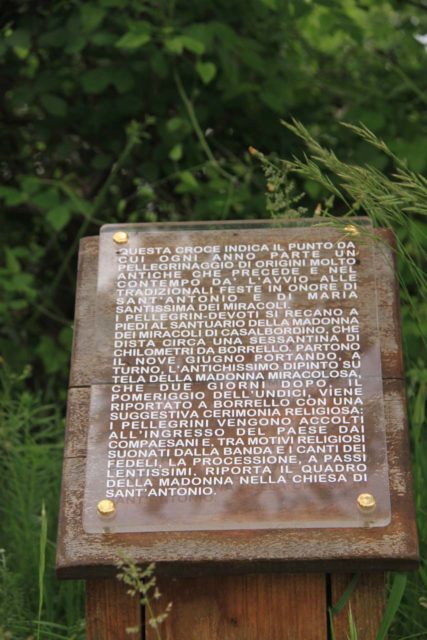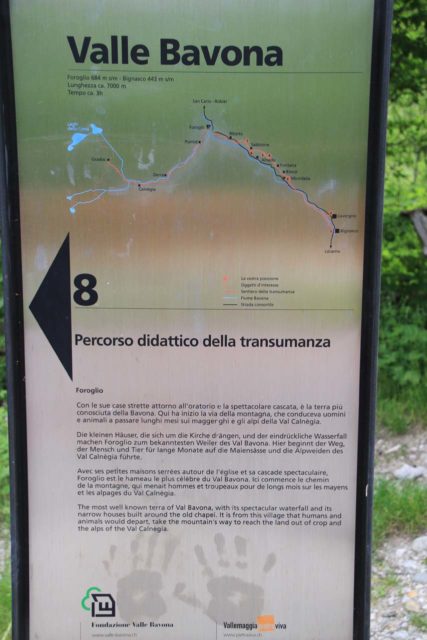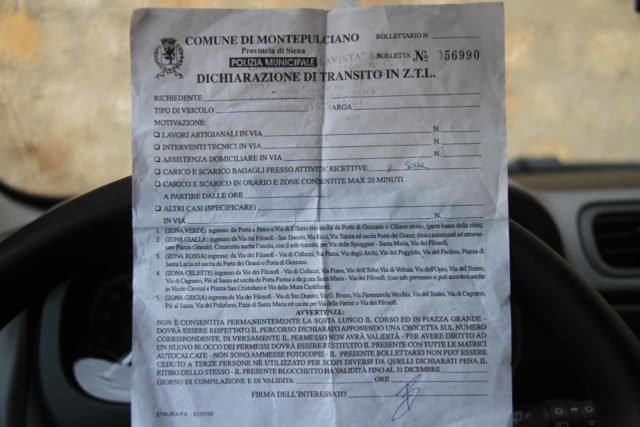One of the things that I learned when Julie and I turned our waterfalling attention internationally was that travel was all about building bridges between your own perception of the world and the actual experiences in the real world.
And so I realized that one of the best ways to build this bridge was to try to learn the local language as this would help me to keep an open mind and be prepared to expand my horizons as I went.
Besides, I feel that trying to speak the local language (no matter how awkward it might be at first) goes a long way towards being encouraged while also being greeted with kindness as opposed to the opposite reation when you expect or even demand the locals to speak English.
In the case of Italian, I had given myself about 6 months or so in preparation for our visit to Italy in May-June 2013. I knew full well that we would be going into some of the more rural parts of the country where it was unlikely that English would be spoken.
So there was even more pressure to try to pick up the language and at least be in position to communicate in Italian when the situation arises where English would not be used. Fortunately, the Italian language was the third Romantic (latin-based) language that I tried to learn after Spanish and French so I at least had a little bit of a head start with this language.
The point of this page is to familiarize you with the language of Italian and perhaps motivate you to give the language a go.
I won’t try to pretend that I’m fluent in the language because I’m not. Nevertheless, in this page, I’ll delve into what I went through to get up to my current understanding of Italian. I’ll also try to divulge all that I know about the language to at least get you acquainted with it.
Hopefully, you’ll find this page useful…
Jump down to: The Learning Process ♦ Reviews of Learning Resources ♦ Some Useful Expressions ♦ Some Useful Vocabulary ♦ Conclusion
The Learning Process
I essentially did my learning of Italian through a single course that included a textbook and some audio CDs from Teach Yourself. I pretty much went through all of the lessons from start to finish, and all of my Italian before the trip was exclusively through this resource.
I’ll go further into a review of this language course in the next section.
As for the process of my learning, I basically used my work commute (typically an hour at a time) to get through both the textbook and the audio CDs. I could listen to the audio CDs in the car, and I could read through the textbook little-by-little on the metro.
This method allowed me to go through the lessons at my own pace without costing me any of my free time outside my normal day-to-day work routines. In fact, I could argue that doing this during the commute was a far more productive use of this time than say listening to talk radio or whatever else was on the radio.
It’s infinitely better than filling up my mind with road rage. I was even able to review or go back through chapters before proceeding onto the next chapter once I was learning while on the train.
I was fortunate to have an Albanian co-worker who knew Italian so I would try some expressions with him to test what I had learned in the lessons. Some of our exchanges weren’t really covered in the lessons so that got me to think a little outside the structured learning.
Eventually after about 6 months of doing this (I managed to get through the Italian textbook twice and the CDs many more times than that), I felt fairly ready to give Italian a go during our trip…
Reviews of Learning Resources
The following are some of the resources that I’ve used to self-learn or self-reinforce what I’ve learned.
Teach Yourself: Complete Italian
Overall Rating: 3.5/5
This Teach Yourself product was a little bit different than the other Teach Yourself Lessons I had used for other languages in that it employed what they called the “discovery method.”
In my mind, what that really meant was that they’d throw in some vocabulary or expressions in the current chapter or lesson that had no translation or other means to at least figure out what those mysterious words or phrases meant (almost all of the time, it was never in the glossary in the back of the book, either).
In a way, it kind of frustrated me to not know at the time what the word or phrase meant so it stuck with me until the next chapter when the meaning might finally be revealed. So I guess by “discovering” its meaning later on, perhaps it might stick with me longer than if it was revealed to me at the time I first encountered it.
I’m not sure if that method was effective or not, but I guess it stimulated me to wonder or keep questioning what I was reading. I really had to figure out the meaning through context.
If I wasn’t successful, I knew that perhaps I wouldn’t understand the conversation at the moment, but I could always go back and review later and eventually read through the lesson on that second go-around with better flow and understanding. So indeed, the initial read through and learning was painful, but it eventually became more useful and smoother later on.
The course went through all of the basic expressions and vocabulary in much the same manner as the rest of the Teach Yourself products, which meant they tried to give you new situations with each new chapter to try to help you learn the new vocabulary and expressions in context.
I was able to talk to my Albanian friend, who then complimented me by saying I sounded like a native speaker especially where I was stressing the syllables. So perhaps this course should get credit for that with its pronunciations, too.
My only gripe with this lesson was that it wasn’t as fun as it could be by stringing together the situations and chapters in a coherent story. Instead, there was just a series of random situations, but no real character attachment so I was never really as motivated or as stimulated to wonder what would come next in the next lesson.
Thus, I didn’t give this product a 4 or 5 rating given the lack of that fun factor.
Bottom line is that I thought this was a pretty solid product, especially given the price paid, but there was plenty of room for improvement.
Some Useful Expressions
Here’s a list of some very basic expressions that I have come across in my travels. Hopefully, you’ll find these to be useful.
To learn more expressions or go through a much more comprehensive list than this, I’d recommend checking out more authoritative resources than this, however.
- Buongiorno / Buona sera / Buona notte – Good Good day / Good evening / Good night
- Arrivederci – Goodbye (at any time of day)
- Scusi / Permiso – Excuse me
- Sa dov’é…? – Do you know where is … ?
- (Molte) Grazie / Grazie (Mille) – Thanks (a lot); the latter is like saying a thousand thanks
- Prego! – Depending on the context, it could mean “Please, go ahead…” or “You’re welcome”
- Come sta? – Formal way of saying “How are you?”
- (Sto) (molto) bene. E lei? – (I am) (very) well. And you?
- Quant’é? – How much is it?
- Per favore / Per piacere Please
- Che cos’é? / Cos’é? – What is it?
- Parla inglese? – Do you speak English?
- Come si dice … in italiano? – How do you say … in Italian?
- Allora, … – So…, Well…, Then… (depending on the context); this is a filler word you hear a lot in Italy (very much like the word “Alors” in French). It’s like in English how we toss in a “So…” between sentences.
- Zona trafico limitato (ZTL) – Limited traffic area. Signs denoting ZTLs tend to be cirular signs with a red circumference and a white filling. I’ve generally seen these signs in pedestrian only zones where you’re not allowed to drive without a permit. Be very careful with these as there are hidden cameras known to catch unsuspecting foreign drivers resulting in a traffic ticket sent to them months after their trip is over!
Some Useful Vocabulary
I’m sure there can be any number of words that would be helpful to know, but I’m going to do things a little differently and try to bias this vocabulary list with things more related to waterfalls or other geographical features.
I figure that might at least help you read some maps or at least have a better understanding of what some of the local place names mean.
- la cascata / le cascate – the waterfall / the waterfalls. Example: La Cascata delle Marmore is Marmore Falls or Le Cascate del Dardagna is the Dardagna Waterfalls.
- la montagna – the mountain
- il fiume – the river. Example: Il Fiume Tivere is the Tiber River.
- il lago – the lake. Example: Il Lago di Como is the Lake Como.
- il duomo – the cathedral (note: although it’s tempting to think it means “the dome”, apparently, the word for dome is la cupola).
- il ponte – the bridge. Example: Il Ponte Vecchio is the Old Bridge (in Florence or Firenze).
- la valle – the valley. Note for place names, I’ve noticed that they shorten the word to just la val. Example: La Val d’Orcia is the famous Orcia Valley in Tuscany or Toscana, but I’ve also seen La Valle Bavona, which is Bavona Valley.
- il sentiero – the trail
- la autostrada – the freeway or highway; like the Italian equivalent of the French autoroute or German autobahn.
Typically, the best-kept or smoothest autostradas require a toll. - il parco – the park. Example: Il Parco Nazionale is the National Park.
- il centro – the center; typically used to denote the city center. Example: il centro storico is the historical center of a city or town.
- l’isola – the island. Example: L’isola del Liri is the Island of Liri, which is a historical city surrounded by the splitting of the river Liri where each split has a waterfall.
- la costiera – the coast. Example: La Costiera Amalfitana is the Amalfi Coast.
Lastly, it’s worth noting that the place names you may be familiar with concerning Italy are not likely to be used in the country itself. So I’ll provide a quick breakdown of some common cities or regions so you can make the mental translation when you look at maps or signs.
- Rome – Roma
- Florence – Firenze
- Venice – Venezia
- Tuscany – Toscana
- Naples – Napoli
- Milan – Milano
Conclusion
From our 2013 trip to Italy, we were able to get by on most of our trip without having to reach deeply into my Italian abilities. However, there were several occasions where it definitely paid off to go through the 6-month self-taught lessons.
This included incidents where…
- I found myself talking to a local in Abruzzo,
- I tried to communicate with a non-English-speaking proprietor in a restaurant due to Julie’s food poisoning episode in the town of Arpino,
- I asked for directions to get to Le Cascate del Dardagna a couple hours north of Florence,
- and I spoke on the phone to a non-English-speaking grandmother of a B&B proprietor, who helped us to arrange for a ride from the airport to their property.
That last conversation was probably the most stressful one yet it worked out and was probably my proudest moment of my Italian speaking adventure.
Plus, I was able to read all the signs while driving the roads, and that also helped immensely.
Needless to say, making the effort to learn Italian certainly paid off during our month-long trip, and it even gave us the confidence that we had what it took to go to those off-the-beaten path places like Abruzzo, Umbria, Lazio, etc.
That had the added benefit of allowing us to mix up our trip so we wouldn’t get so much medieval fatigue from seeing one charming town after another. The Nature, which was way off the beaten path really helped us out in that respect!
Even when we went to southern Switzerland, it seemed like there was more Italian spoken there than German (which was ironic considering the far north of Italy [especially the Dolomites] spoke more German than Italian). So the Italian lessons once again helped us out.
Finally, I want to conclude by saying that structured learning from lessons can get you to a point where you can have enough confidence to try the language in a real life situation (and our Italian trip was living proof of that).
Yet I definitely recognized that despite my familiarity with the very basic expressions and vocabulary, I knew that I was nowhere near fluency. That only comes from actually living there and being forced to use it every day.
Anyways, by just giving the language a try, we experienced firsthand how it helped us connect with some of the locals a lot more easily, and thus it made the travel experience that much more enjoyable.
Don’t be discouraged by awkward exchanges at first as more often than not, I’ve observed that people are genuinely pleased and more encouraging when you try to speak their language.
Besides, you’ll never know if you don’t try, and who knows where your learning will take you next? So what have you got to lose?
Visitor Comments:
Got something you'd like to share or say to keep the conversation going? Feel free to leave a comment below...No users have replied to the content on this page




